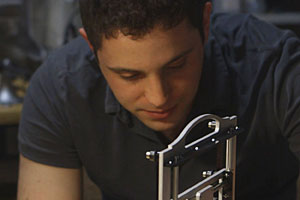
Clay Tweel has no hesitation about citing what he would use a 3-D printer for. An incident during his and co-director Luis Lopez’s 18-month shoot for their documentary on the subject, Print the Legend, intently focused his mind on the practical applications of being able to reproduce something themselves.
“We broke our tripod,” Tweel says . “All it was was a little plastic button and we called the company and they were like, ‘Oh, it’s US$50 for a replacement’. That blew my mind – it was like 50c worth of plastic.”
Tweel and Lopez are now something akin to experts on 3-D printing after following the fortunes of companies like MakerBot Industries, Formlabs and 3DSystems as they battle to bring 3-D printers to our desktops and everyday lives.
However, the pair, who had worked together on 2007’s 1980s-gaming culture doco The King of Kong, actually started out this time wanting to make a movie about Steve Jobs and Apple.
“We wanted to do a fresh and exciting take on that. We read the Steve Jobs bio by Walter Isaacson and were struck by the fact that half of it was about how ruthless and hypocritical Steve Jobs was and the other half was how genius and far-sighted he was in creating the products that we love and use so much today. Our problem was getting that into a movie.
“Then, at the same time, we started hearing all these stories about 3-D printing and the parallels to the PC revolution of the late 1970s and early 80s. So we decided to go and talk to some of these people like MakerBot’s Bre Pettis and Formlabs’ Max Lobovsky and we discovered that the industry was moving so fast that these guys might just be somebody who we could see if their trajectory matched what we read in the Jobs book.”
Charting the growing pains, successes and failures of these two companies and others, the resulting film is a fascinating, fly- on-the-wall look at not only a nascent industry but also American entrepreneurship in the 21st century.
“We didn’t know anything about 3-D printing beforehand, we just committed ourselves to doing as much research online as possible and luckily the people at MakerBot and Formlabs were really good at explaining how things work and educating you in layman’s terms about the potential of the technology and how it works.
“However, while our movie definitely has its fair share of talking heads, we’re both big fans of observational, cinema verite- style films and wanted to make you feel you’re in the moment as much as possible.”
One of the surprising things about Print the Legend is the candour of those talking, particularly about where their companies have gone wrong.
Tweel says while there were some tricky situations in dealing with companies with investors, shareholders and bottom lines to protect, building relationships and being prepared to ask the same question multiple times were the keys to “really get the answers that aren’t on a PR sheet”.
He says it also took a lot of time to try to establish the personal motivations of people and why they did what they did. However, Tweel believes it probably helped that entrepreneurs and film- makers share the same sense of idealism.
Ad Feedback
“You need that and passion to make a film or build a 3-D printing company from scratch. We also saw the flipside of that, too – the kind of harsh business realities that challenge your idealism, ethics and integrity in lots of ways.
“And that’s the really interesting part of this story.”
It’s a theme that was also ingrained in the DNA of Oscar- winning 2010 drama The Social Network, a film that Tweel cites as inspiration for theirs, especially as Mark Zuckerberg-Eduardo Saverin-esque fallouts played themselves out in front of them.
WHEN asked why he thinks tech companies all seem to suffer that kind of internal implosion, Tweel is diplomatic.
“It’s really hard to be working 20 hours a day on something and find somebody that you agree with on every decision. Also, you always seem to find that classic model from the Steve Jobs Apple era, where you have a PT Barnham-esque character and an engineer [in Apple’s case Steve Wozniak] who are both very much needed to make a business succeed, but have very different priorities.”
One man who had different priorities when it came to 3-D printing was Cody Wilson. Tweel and Lopez first heard about the self-described “information anarchist” at a 3-D Print Conference where word spread he was trying to print a 3-D gun.
“We immediately tried to contact him. It was just a little bit of serendipity that we were able to be there when he uploaded the plans for the gun. That was like a special little bit of 3-D history that we caught on camera.”
Unsurprisingly, the idea of people printing their own guns at home is something that sends a shudder through many, but what does Tweel think the future of 3-D printing will be
“I think it’s totally possible that it will go the same way as Blu-ray or VHS – that one standard will emerge. However, the industry is so young it’s really hard to see into the future of what it’s going to be. We don’t know if this could be like the mini-disc, either – it could completely go away in three years. That’s why we were hoping the film could really show an example of businesses growing in a kind of time capsule sort of quality for this industry.
“In five years, all these people could be gone and just one company remain. But, really, we have no idea.”